电子科技大学:《贝叶斯学习与随机矩阵及在无线通信中的应用 BI-RM-AWC》课程教学资源(课件讲稿)04 Asymptotic Spectrum Theorems(3/4)
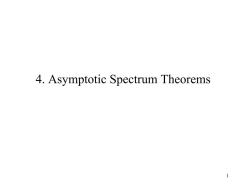
4.Asymptotic Spectrum Theorems 1
1 4. Asymptotic Spectrum Theorems
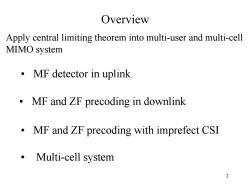
Overview Apply central limiting theorem into multi-user and multi-cell MIMO system ·MF detector in uplink MF and ZF precoding in downlink MF and ZF precoding with imprefect CSI ·Multi--cell system 2
2 Overview • MF detector in uplink • MF and ZF precoding in downlink • MF and ZF precoding with imprefect CSI • Multi-cell system Apply central limiting theorem into multi-user and multi-cell MIMO system

4.4 Central Limiting Theorem User User User Base station User Consider a MU-MIMO system with a single cell,where has K single-antenna users and one BS with N antennas. 3
3 4.4 Central Limiting Theorem Consider a MU-MIMO system with a single cell, where has K single-antenna users and one BS with N antennas
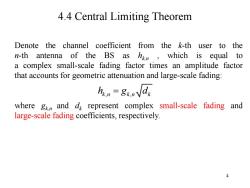
4.4 Central Limiting Theorem Denote the channel coefficient i from the k-th user to the n-th antenna of the BS as hk.n,v which is s equal to a complex small-scale fading factor times an amplitude factor that accounts for geometric attenuation and large-scale fading: hn =gknYdk where gkm and d represent complex small-scale fading and large-scale fading coefficients,respectively. 4
4 4.4 Central Limiting Theorem Denote the channel coefficient from the k-th user to the n-th antenna of the BS as hk,n , which is equal to a complex small-scale fading factor times an amplitude factor that accounts for geometric attenuation and large-scale fading: where gk,n and dk represent complex small-scale fading and large-scale fading coefficients, respectively. k n k n k , , h g d
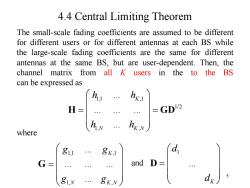
4.4 Central Limiting Theorem The small-scale fading coefficients are assumed to be different for different users or for different antennas at each BS while the large-scale fading coefficients are the same for different antennas at the same BS,but are user-dependent.Then,the channel matrix from all K users s in the to the BS can be expressed as H= h.N where hi.N g1,1 8K,1 G and D 81,N 8K.N
5 4.4 Central Limiting Theorem The small-scale fading coefficients are assumed to be different for different users or for different antennas at each BS while the large-scale fading coefficients are the same for different antennas at the same BS, but are user-dependent. Then, the channel matrix from all K users in the to the BS can be expressed as where and 1,1 ,1 1/2 1, , ... ... ... ... ... K N K N h h h h H GD 1,1 ,1 1, , ... ... ... ... ... K N K N g g g g G 1 ... K d d D
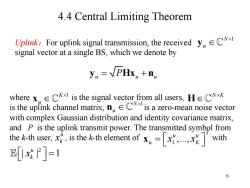
4.4 Central Limiting Theorem Uplink:For uplink signal transmission,the received y signal vector at a single BS,which we denote by y =PHx+n where x CK is the signal vector from all users,HECNxK is the uplink channel matrix,is a zero-mean noise vector with complex Gaussian distribution and identity covariance matrix, and P is the uplink transmit power.The transmitted symbol from the k-th user,is the k-th element ofwith [x门=1 6
6 4.4 Central Limiting Theorem Uplink:For uplink signal transmission, the received signal vector at a single BS, which we denote by N 1 u y y Hx n u u u P where is the signal vector from all users, is the uplink channel matrix, is a zero-mean noise vector with complex Gaussian distribution and identity covariance matrix, and P is the uplink transmit power. The transmitted symbol from the k-th user, , is the k-th element of with K 1 u x N 1 u n N K H T 1 ,..., u u u K x x x u k x 2 | | 1 u k x
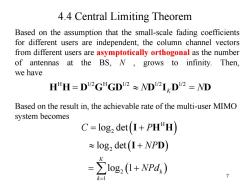
4.4 Central Limiting Theorem Based on the assumption that the small-scale fading coefficients for different users are independent,the column channel vectors from different users are asymptotically orthogonal as the number of antennas at the BS,N,grows to infinity.Then, we have HHH-DIGHGD2 NDIID2 =ND Based on the result in,the achievable rate of the multi-user MIMO system becomes C=log2 det(I+PHH ≈log2det(I+WPD) =∑1og2(1+NPdx) k 7
7 4.4 Central Limiting Theorem Based on the assumption that the small-scale fading coefficients for different users are independent, the column channel vectors from different users are asymptotically orthogonal as the number of antennas at the BS, N , grows to infinity. Then, we have H 1/2 H 1/2 1/2 1/2 H H D G GD D I D D N N K Based on the result in, the achievable rate of the multi-user MIMO system becomes H 2 2 2 1 log det log det log 1 K k k C P NP NPd I H H I D
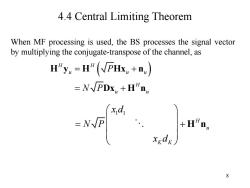
4.4 Central Limiting Theorem When MF processing is used,the BS processes the signal vector by multiplying the conjugate-transpose of the channel,as H"y,=H"PHx+n) =N√PDx+HnW xd =NP +Hn xkdk 8
8 4.4 Central Limiting Theorem When MF processing is used, the BS processes the signal vector by multiplying the conjugate-transpose of the channel, as 1 1 H u K K x d N P x d H n H H u u u H u u P N P H y H Hx n Dx H n
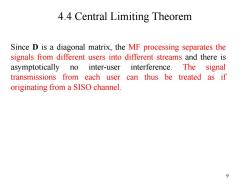
4.4 Central Limiting Theorem Since D is a diagonal matrix,the MF processing separates the signals from different users into different streams and there is asymptotically no inter-user interference.The signal transmissions from each user can thus be treated as if originating from a SISO channel. 9
9 4.4 Central Limiting Theorem Since D is a diagonal matrix, the MF processing separates the signals from different users into different streams and there is asymptotically no inter-user interference. The signal transmissions from each user can thus be treated as if originating from a SISO channel
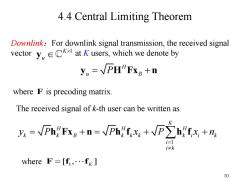
4.4 Central Limiting Theorem Downlink:For downlink signal transmission,the received signal vector y at Kusers,which we denote by y=PH"Fx8+n where F is precoding matrix. The received signal of k-th user can be written as y=PhgFxg+n=Pnf+Phfx+ng i=l i≠k where F=[f,…fk] 10
10 4.4 Central Limiting Theorem Downlink:For downlink signal transmission, the received signal vector at K users, which we denote by K 1 u y H y H Fx n u B P where is precoding matrix. F The received signal of k-th user can be written as 1 K H H H k k B k k k k i i k i i k y P P x P x n h Fx n h f h f where 1 [ , ] F f f K
按次数下载不扣除下载券;
注册用户24小时内重复下载只扣除一次;
顺序:VIP每日次数-->可用次数-->下载券;
- 电子科技大学:《贝叶斯学习与随机矩阵及在无线通信中的应用 BI-RM-AWC》课程教学资源(课件讲稿)04 Asymptotic Spectrum Theorems(2/4).pdf
- 《贝叶斯学习与随机矩阵及在无线通信中的应用 BI-RM-AWC》课程教学资源(文献书籍)An Introduction to Random Matrices(Greg W. Anderson、Alice Guionnet).pdf
- 电子科技大学:《贝叶斯学习与随机矩阵及在无线通信中的应用 BI-RM-AWC》课程教学资源(课件讲稿)04 Asymptotic Spectrum Theorems(1/4).pdf
- 电子科技大学:《贝叶斯学习与随机矩阵及在无线通信中的应用 BI-RM-AWC》课程教学资源(课件讲稿)03 Transforms.pdf
- 电子科技大学:《贝叶斯学习与随机矩阵及在无线通信中的应用 BI-RM-AWC》课程教学资源(课件讲稿)02 Types of Matrices and Local Non-Asymptotic Results.pdf
- 电子科技大学:《贝叶斯学习与随机矩阵及在无线通信中的应用 BI-RM-AWC》课程教学资源(课件讲稿)01 Introduction of Wireless Channel and Random Matrices(陈智).pdf
- 《贝叶斯学习与随机矩阵及在无线通信中的应用 BI-RM-AWC》课程教学资源(文献书籍)Random Matrix Theory and Wireless Communications.pdf
- 《贝叶斯学习与随机矩阵及在无线通信中的应用 BI-RM-AWC》课程教学资源(文献书籍)PRML中文版——模式识别与机器学习.pdf
- 《贝叶斯学习与随机矩阵及在无线通信中的应用 BI-RM-AWC》课程教学资源(文献书籍)Pattern Recognition and Machine Learning.pdf
- 电子科技大学:《时域测试技术综合实验 Comprehensive Experiment of Time Domain Testing Technology》课程教学资源(课件讲稿)实验十四 虚拟数字示波器实验.pdf
- 电子科技大学:《时域测试技术综合实验 Comprehensive Experiment of Time Domain Testing Technology》课程教学资源(课件讲稿)实验十三 基于FPGA的地址译码实验.pdf
- 电子科技大学:《时域测试技术综合实验 Comprehensive Experiment of Time Domain Testing Technology》课程教学资源(课件讲稿)实验十二 数字示波器信号调理通道实验.pdf
- 电子科技大学:《时域测试技术综合实验 Comprehensive Experiment of Time Domain Testing Technology》课程教学资源(课件讲稿)实验十一 数字示波器协议触发与解码应用测试.pdf
- 电子科技大学:《时域测试技术综合实验 Comprehensive Experiment of Time Domain Testing Technology》课程教学资源(课件讲稿)实验十 时域反射实验.pdf
- 电子科技大学:《时域测试技术综合实验 Comprehensive Experiment of Time Domain Testing Technology》课程教学资源(课件讲稿)实验九 参数测量实验.pdf
- 电子科技大学:《时域测试技术综合实验 Comprehensive Experiment of Time Domain Testing Technology》课程教学资源(课件讲稿)实验八 数字示波器中的信号插值.pdf
- 电子科技大学:《时域测试技术综合实验 Comprehensive Experiment of Time Domain Testing Technology》课程教学资源(课件讲稿)实验七 信号采集抽取功能设计实验.pdf
- 电子科技大学:《时域测试技术综合实验 Comprehensive Experiment of Time Domain Testing Technology》课程教学资源(课件讲稿)实验六 信号采集触发功能设计实验.pdf
- 电子科技大学:《时域测试技术综合实验 Comprehensive Experiment of Time Domain Testing Technology》课程教学资源(课件讲稿)实验五 数据采集动态性能评估方法.pdf
- 电子科技大学:《时域测试技术综合实验 Comprehensive Experiment of Time Domain Testing Technology》课程教学资源(课件讲稿)实验四 基于FIFO采样与存储.pdf
- 电子科技大学:《贝叶斯学习与随机矩阵及在无线通信中的应用 BI-RM-AWC》课程教学资源(课件讲稿)04 Asymptotic Spectrum Theorems(4/4).pdf
- 电子科技大学:《贝叶斯学习与随机矩阵及在无线通信中的应用 BI-RM-AWC》课程教学资源(课件讲稿)06 Non-asymptotic Analysis for Large Random Matrix.pdf
- 电子科技大学:《贝叶斯学习与随机矩阵及在无线通信中的应用 BI-RM-AWC》课程教学资源(课件讲稿)07 Analysis of neural networks - a random matrix approach.pdf
- 电子科技大学:《贝叶斯学习与随机矩阵及在无线通信中的应用 BI-RM-AWC》课程教学资源(课件讲稿)05 Free Probability.pdf
- 《贝叶斯学习与随机矩阵及在无线通信中的应用 BI-RM-AWC》课程教学资源(学习资料)Random Matrix Theory and Wireless Communications.pdf
- 电子科技大学:《贝叶斯学习与随机矩阵及在无线通信中的应用 BI-RM-AWC》课程教学资源(课件讲稿)08 Linear Regression.pdf
- 电子科技大学:《贝叶斯学习与随机矩阵及在无线通信中的应用 BI-RM-AWC》课程教学资源(课件讲稿)09 Sparse Signal Recovery.pdf
- 电子科技大学:《贝叶斯学习与随机矩阵及在无线通信中的应用 BI-RM-AWC》课程教学资源(学习资料)贝叶斯学习补充材料.pdf
- 电子科技大学:《贝叶斯学习与随机矩阵及在无线通信中的应用 BI-RM-AWC》课程教学资源(学习资料)随机矩阵补充材料 Analysis of neural networks - a random matrix approach.pdf
- 广东海洋大学:《数字信号处理 Digital Signal Processing》课程教学资源(电子教案).doc
- 电子科技大学:《ASIC设计 Application Specific Integrated Circuit Design(ASIC)》课程教学资源(课件讲稿)Topic 1 Introduction(About IC technology).pdf
- 电子科技大学:《ASIC设计 Application Specific Integrated Circuit Design(ASIC)》课程教学资源(课件讲稿)Topic 1 Introduction(About ASIC Design).pdf
- 电子科技大学:《ASIC设计 Application Specific Integrated Circuit Design(ASIC)》课程教学资源(课件讲稿)Topic1 Introduction(About Our Course).pdf
- 电子科技大学:《ASIC设计 Application Specific Integrated Circuit Design(ASIC)》课程教学资源(课件讲稿)Topic 2 FPGA Design with Verilog(FPGA Design Method、Design Examples).pdf
- 电子科技大学:《ASIC设计 Application Specific Integrated Circuit Design(ASIC)》课程教学资源(课件讲稿)Topic 2 FPGA Design with Verilog(Supplementary).pdf
- 电子科技大学:《ASIC设计 Application Specific Integrated Circuit Design(ASIC)》课程教学资源(课件讲稿)Topic 3 Verification and Test.pdf
- 电子科技大学:《ASIC设计 Application Specific Integrated Circuit Design(ASIC)》课程教学资源(课件讲稿)Topic 4 VLSI for DSP.pdf
- 电子科技大学:《高等数字集成电路设计 Advanced Digital Integrated Circuits Design》课程教学资源(教学大纲,负责人:贺雅娟).pdf
- 电子科技大学:《高等数字集成电路设计 Advanced Digital Integrated Circuits Design》课程教学资源(课件讲稿)Lecture 1 Introduction & The Fabrics.pdf
- 电子科技大学:《模拟集成电路分析与设计 Analysis and Design of Analog Integrated Circuit》课程教学资源(教学大纲,负责人:罗萍).pdf
